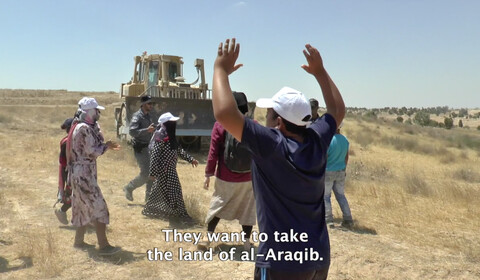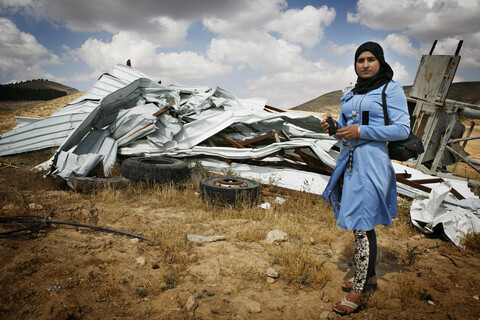The Electronic Intifada 15 August 2016

“With the demolitions, the kids get scared. It’s really hard but we keep going. Israel wants us to leave but we stay put. We have our faith,” says Bilal Hammadin, 22, resident of Abu Nuwwar village near Jerusalem.
Bilal Hammadin looks beyond the tin shacks in the occupied West Bank village of Abu Nuwwar, home to approximately 600 Palestinians, to the red-roofed homes in Maaleh Adumim, an Israeli settlement where nearly 40,000 people live.
“As I was growing up, I could see the settlement getting bigger. I guess you can say that we grew up together,” he says, laughing at the irony.
Hammadin knows all too well that the expansion of the settlement – built in violation of international law, which forbids an occupying power like Israel from transferring its population into the territory it occupies – has meant the steady de-development of his community.
In February, the Israeli army demolished two trailers which were to serve as a new school for first- and second-graders. The cabins, donated by a French nongovernmental organization and funded by the European Union, bore visible EU logos.
150 donor-funded structures demolished
This month France condemned Israel’s demolition of buildings in Nabi Samuel village funded by French humanitarian aid. Israel has destroyed or confiscated French-funded structures, including a school, three times in the village so far this year.
In the past, these large stickers bearing the EU logo offered a modicum of protection from demolitions. But this year, at least 150 European-funded structures in the West Bank were demolished by Israeli bulldozers in the first three months of 2016.
Some observers – including a far-right Israeli politician who has advocated for the demolitions – suggest the spike in destruction of EU-funded structures is retaliation for the EU’s new regulations requiring labelling of Israeli settlement goods issued late last year.
Israeli demolitions of Palestinian structures in the West Bank on the whole increased threefold during the first quarter of 2016 over the previous rate of 50 demolitions per month between 2012 and 2015.
Most of those demolitions took place in Area C, the 60 percent of the West Bank under total Israeli control per the terms of the 1993 Oslo accords signed by Israel and the Palestine Liberation Organization.
Israel issues demolition orders on the pretext that structures were built without a permit. But between 2010 and 2014, Israeli authorities approved only 1.5 percent of Palestinian applications for building permits in Area C.
Protest but no accountability
In a letter to the Israeli military, eight ambassadors to Israel protested the “dismantling and confiscation” of European-funded shelters in May and June this year.
On Friday, the EU’s external affairs spokesperson condemned the upsurge in demolitions, including of EU-funded structures.
Israel “must halt demolitions of Palestinian houses and property, in accordance with its obligations as an occupying power under international humanitarian law,” the spokesperson added, and “cease the policy of settlement construction and expansion, of designating land for exclusive Israeli use and of denying Palestinian development.”
But so far there has been no move by the EU – which lavishes funding on Israel, including for research projects on occupied land – towards accountability for the demolitions. And so Palestinian communities brace for more destruction.
Silvia Boarini is a photojournalist based in Jerusalem. She is the co-director of the documentary Empty Desert.
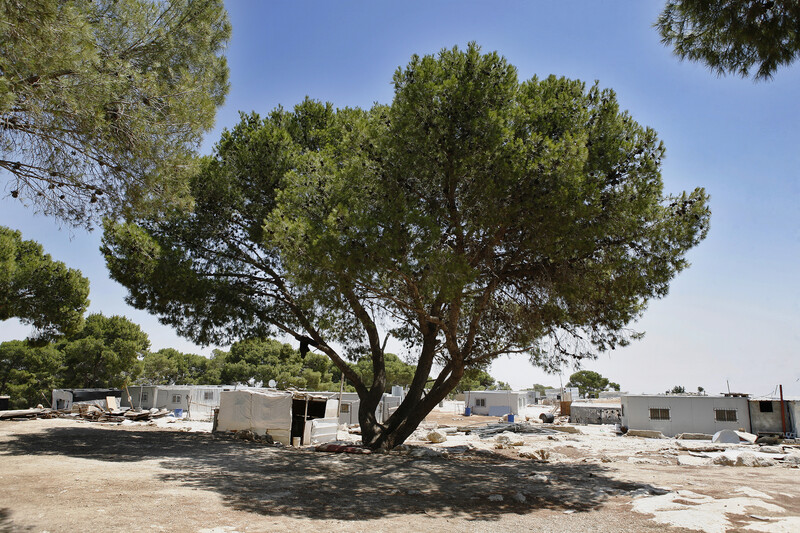
Jabal al-Baba is a village home to some 300 members of the Jahalin Bedouin tribe, who were forcibly transferred from Tel Arad in the south of present-day Israel following the establishment of the state in 1948. The area is named Jabal al-Baba, literally the Pope’s Mountain, because the hill was bequeathed by King Hussein of Jordan, which administered the West Bank between 1948 and 1967, to the Vatican on the occasion of a papal visit in 1964. The Bedouin village is next to Vatican property on land that is privately owned by Palestinians in al-Eizariya but which since 1967, the year Israel occupied the West Bank, has partly been declared state land.
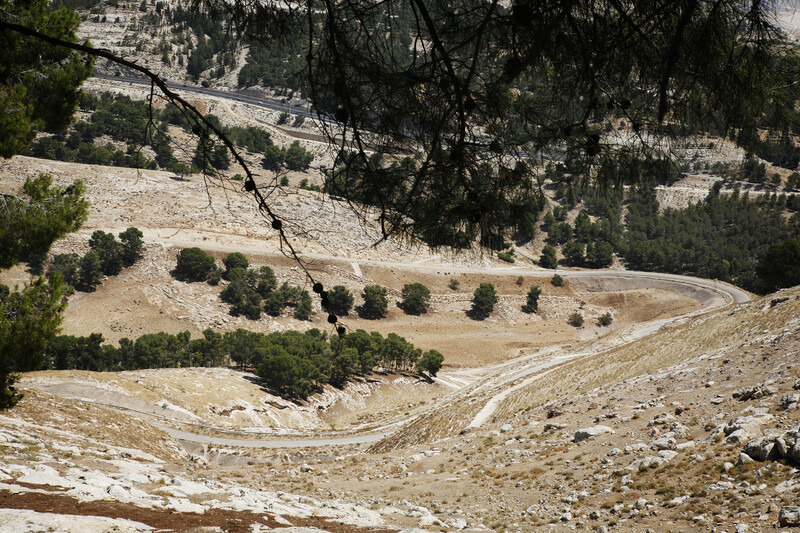
Once completed, Israel’s wall in the West Bank, which in this location currently consists of barbed wire, will sever Jabal al-Baba from the town of al-Eizariya. The Bedouin community depends on the town for services such as education and health clinics, and the wall will effectively trap the Bedouins on the “Israeli” side. The wall has already limited the grazing areas accessible to the agrarian community.

“We have no more space to graze our flocks, the wall is all around us and they demolish our homes. Israel is strangling us,” says Atallah Mazara, head of the village committee in Jabal al-Baba. Since its establishment in 1975, Maaleh Adumim settlement, to the east of Jabal al-Baba, has expanded, taking over land previously used for grazing livestock by the local Bedouin communities.

One of the EU-funded shelters demolished by Israel in Jabal al-Baba on 16 May 2016. A total of 10 structures were dismantled and confiscated, leaving some 49 people without shelter. Jabal al-Baba is one of many Bedouin hamlets that Israel views as an obstacle to territorial continuity in the corridor known as E1, which if developed would connect Maaleh Adumim settlement with Jerusalem. Bedouin communities in E1 are not accommodated for in Israel’s master plan for the area.
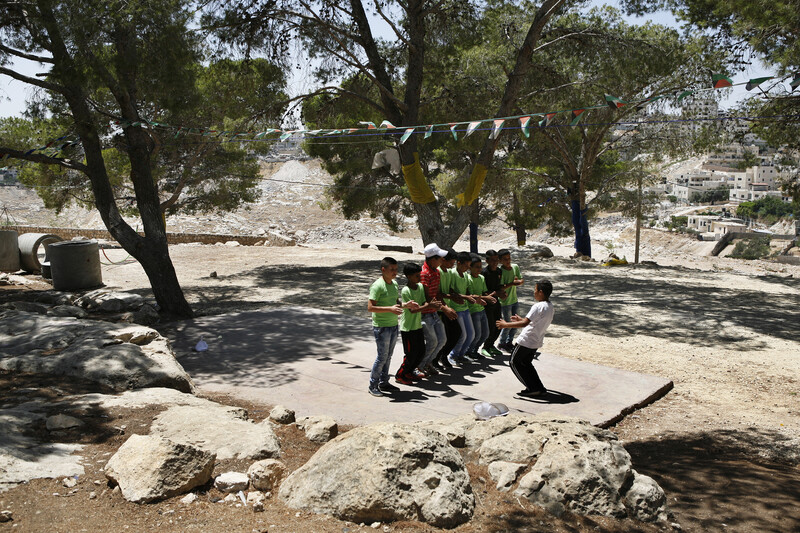
Boys from Jabal al-Baba take part in a summer camp. The Bedouin community has been able to set up a tent for guests on Vatican land. The structure is used for community activities and to welcome international guests.
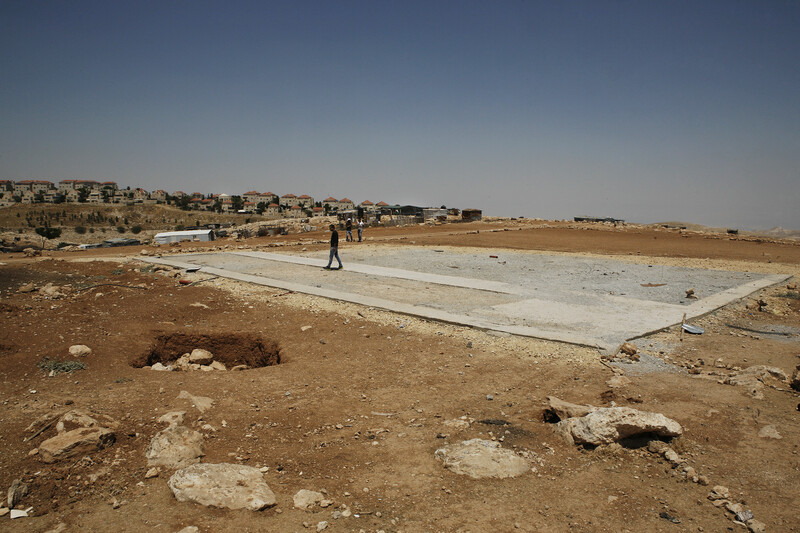
An empty concrete slab is the former site of two trailers serving as classrooms in the village of Abu Nuwwar, also in the E1 corridor. The EU-funded structures were confiscated in the early morning of 20 February 2016, just one day after they had been installed by a French non-governmental group.

Elementary school students in Abu Nuwwar must travel by donkey to Wadi Abu Hindi, more than two kilometers away, for class. “It takes half an hour each way. If there was a bus it would be much easier, especially when it rains in winter,” says Bara Hammadin, 16 years old, seen here in the Abu Nuwwar kindergarten. Residents explain that an Israeli court ruling protects structures built prior to 2010, such as this kindergarten and most of the homes in Abu Nuwwar, from being demolished. But a ban on new construction does not accommodate the natural growth of the village, including building a primary school. The Jahalin are involved in a number of legal battles for the right to remain and expand where they currently reside.
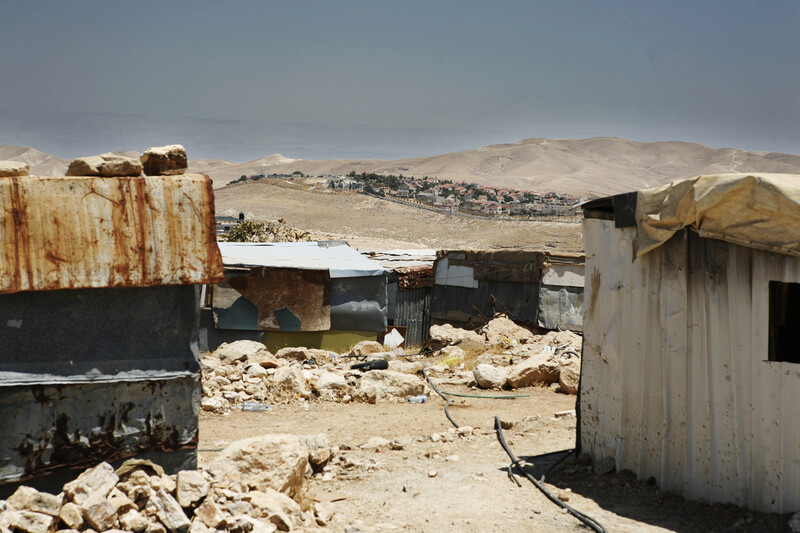
To the south, beyond the shacks of Abu Nuwwar, lies the settlement of Kedar. Like Jabal al-Baba, Abu Nuwwar is viewed by Israel as an obstacle to settlement expansion in the E1 corridor.
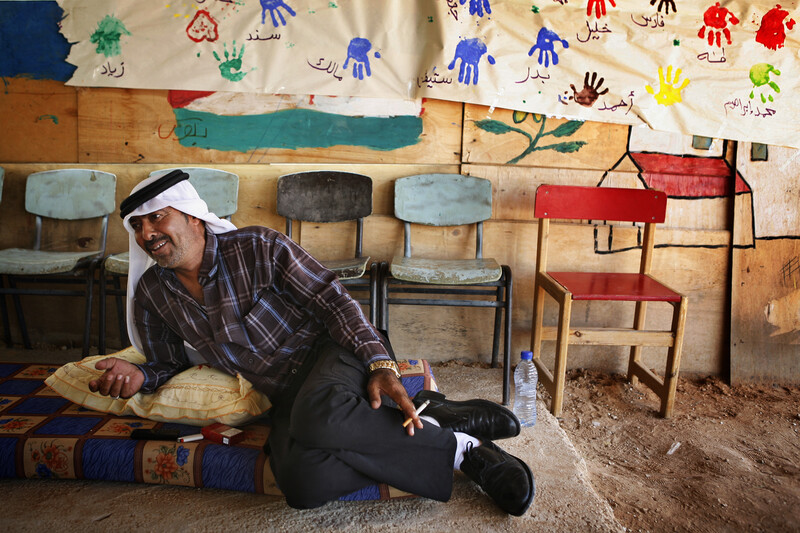
Younes Hamadeen of Abu Nuwwar sits outside the kindergarten. “They would like us to live somewhere between the ground and the sky,” he jokes, referring to the obstacles that Israel imposes to prevent the development of the Jahalin communities. “We don’t want anything from Israel, just that they let us be. We have our own system, our own way of living, we just want to stay where we are.”

Khalil Hathaleen outside his home in Umm al-Kheir village in the South Hebron Hills. “They tell us we are all the same, blacks and whites, but here, we are really not,” he says. With a population of approximately 200 people belonging to the Jahalin clan, Umm al-Kheir is an Area C community under full Israeli control; next to it is the Israeli settlement of Carmel. Residents in Umm al-Kheir are not connected to the water or electricity networks, while the settlement enjoys these services.

Khalil Hathaleen in his home. Gesturing eastwards towards a nearby hamlet also known as Umm al-Kheir, which is included in Israel’s master plan for the area, he says: “They want us to move over there but that land is not ours, it belongs to other families, we can’t just go there.”
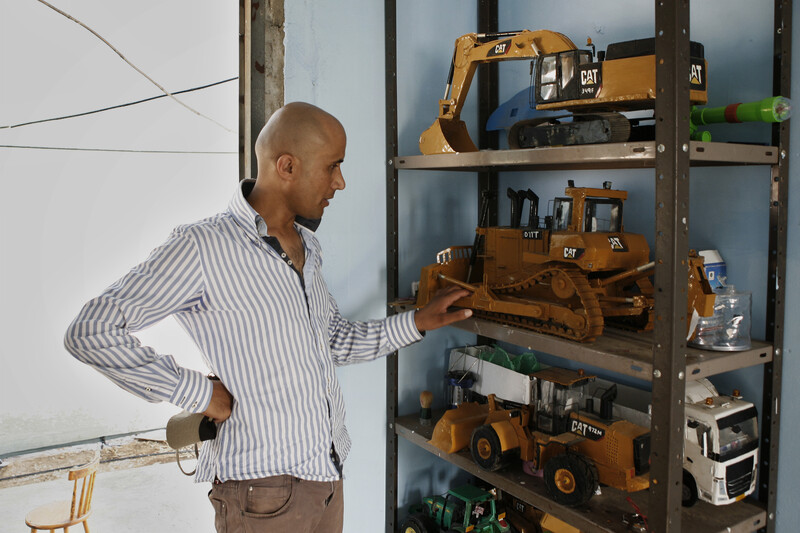
“Having the EU logo on the homes helped us for a while but in reality Israel is not scared of the EU,” says Umm al-Kheir resident Eid Hathaleen, who uses debris from demolitions to build models of machinery used by Israel to destroy homes and infrastructure. His work will be featured in an upcoming exhibition curated by Chinese artist Ai Weiwei in Berlin. “You can see it, life is very hard here, it’s like the far West,” he says, noting that settlers coming to remote areas like the South Hebron Hills believe they are on a mission to conquer land. “They tend to be aggressive types, not interested in conversation,” he adds.
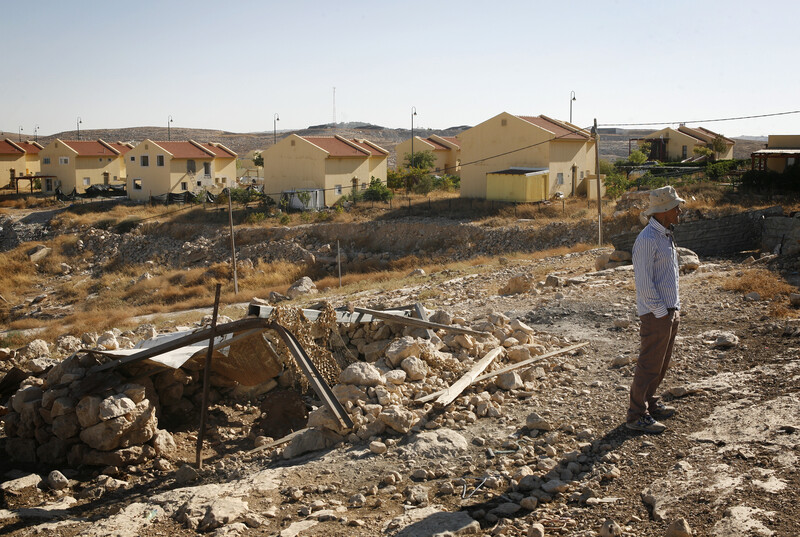
The traditional *taboun* oven in Umm al-Kheir, seen in the foreground, has been the subject of many disputes with settlers in Carmel, seen in the background. The oven, used to bake bread, has been a central feature of the village for decades but since the expansion of the settlement 10 years ago, a legal battle has raged over its fate. Settlers have sought to have the oven removed, claiming that the fumes were a nuisance and health hazard. Settlers have raided the village multiple times — once in the company of Israeli soldiers — and extinguished the oven.

A concrete slab where a house stood until a demolition two years ago and a pile of rubble where a new shelter was demolished on 6 April 2016. Next to the empty slab and ruins is a trailer assembled following the April demolition. Villagers explain that once a building is demolished, they cannot rebuild it in exactly the same spot but will try to erect it a few meters away.
